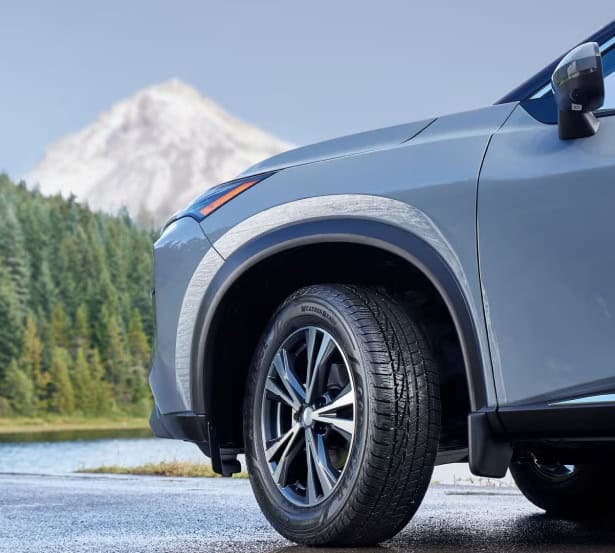The Ford Ranger is a versatile pickup truck that requires proper tire maintenance for optimal performance, safety, and fuel efficiency. This guide will help you understand codes, pressure recommendations, and other essential information specific to the Ford Ranger, with a focus on metric measurements and summer conditions.

What Are Tire Codes?
Tire codes contain crucial information about the size, load capacity, and speed rating of your tires. Let’s break down a typical code for a Ford Ranger:
Example: 255/70R16 111T
- 255: Width in millimeters
- 70: Aspect ratio (height as a percentage of width)
- R: Radial construction
- 16: Rim diameter in inches
- 111: Load index
- T: Speed rating
Common Ford Ranger Tire Sizes
- 255/70R16: Standard on many Ranger models
- 265/65R17: Often found on higher trim levels
- 245/75R16: A popular all-terrain option
- 285/70R17: Larger size for off-road enthusiasts
Tire Pressure Recommendations
Proper pressure is crucial for safety, fuel efficiency, and longevity. The recommended pressure can vary based on load, driving conditions, and size.
Summer Tire Pressure Guidelines
For summer conditions, follow these general guidelines:
- Unloaded Ranger:
- Front: 230-240 kPa (33-35 psi)
- Rear: 210-220 kPa (30-32 psi)
- Fully loaded Ranger:
- Front: 240-250 kPa (35-36 psi)
- Rear: 260-280 kPa (38-41 psi)
Note: Always check your vehicle’s tire placard (usually in the driver’s side door jamb) for the manufacturer’s recommended pressures.
Factors Affecting Tire Pressure
- Temperature: Pressure increases by about 7 kPa (1 psi) for every 5.5°C (10°F) rise in temperature. Check pressure when tires are cold for accurate readings.
- Altitude: Pressure decreases by about 2 kPa (0.3 psi) for every 300 meters (1000 feet) increase in altitude.
- Load: Heavier loads require higher pressures, especially in the rear tires.
Tire Load Index and Speed Ratings
Load Index
The load index indicates the maximum weight a tire can support when properly inflated. For the Ford Ranger, common load indexes include:
- 111: 1090 kg (2403 lbs) per tire
- 113: 1150 kg (2535 lbs) per tire
- 115: 1215 kg (2679 lbs) per tire
Speed Ratings
Speed ratings indicate the maximum speed at which a tire can safely operate:
- S: Up to 180 km/h (112 mph)
- T: Up to 190 km/h (118 mph)
- H: Up to 210 km/h (130 mph)
- V: Up to 240 km/h (149 mph)
Most Ford Rangers use tires with S, T, or H speed ratings, which are more than adequate for normal driving conditions.
Tire Types for the Ford Ranger
- All-Season Tires: Suitable for year-round use in moderate climates, offering a balance of performance, comfort, and fuel efficiency.
- All-Terrain Tires: Ideal for Rangers used on and off-road, providing better traction in diverse conditions.
- Mud-Terrain Tires: Best for serious off-road enthusiasts, offering maximum traction in challenging terrain but with increased road noise and reduced fuel efficiency.
- Highway Tires: Designed for Rangers primarily used on paved roads, offering smooth, quiet rides and good fuel economy.
Tire Rotation and Maintenance
Regular rotation helps ensure even wear and extends life. For the Ford Ranger:
- Rotate tires every 8,000 to 13,000 kilometers (5,000 to 8,000 miles).
- Follow a front-to-rear rotation pattern for 4×2 Rangers.
- Use a more complex pattern for 4×4 Rangers to account for the additional drive wheels.
Tire Pressure Monitoring System (TPMS)
Most modern Ford Rangers have a Tire Pressure Monitoring System, which alerts drivers when tire pressure falls below a certain threshold. While this system is helpful, it’s not a substitute for regular manual pressure checks.
Choosing the Right Tires for Your Ford Ranger
Consider the following factors when selecting new rubber:
- Driving conditions: Highway, city, off-road, or a mix
- Climate: All-season vs. specialized summer or winter options
- Load requirements: Ensure the load index meets your needs
- Fuel efficiency: Look for low rolling resistance options
- Noise levels: Consider road noise if it’s a concern
- Tread life: Check warranty and expected lifespan
- Price: Balance cost with quality and performance
Off-Road Considerations
For Rangers used in off-road conditions:
- Consider slightly lower air pressures for better traction (but never below 138 kPa or 20 psi).
- Invest in a portable air compressor to adjust pressures in the field.
- Choose rubber with reinforced sidewalls for better puncture resistance.
- Look for options with a more aggressive tread pattern for improved off-road performance.
Fuel Efficiency
Rubber hoice and maintenance can significantly impact fuel efficiency:
- Proper inflation can improve fuel economy by up to 3%.
- Low rolling resistance options can offer a 5-7% improvement in fuel efficiency.
- Oversized or aggressive off-road wheels can decrease fuel economy by 3-5% or more.
Winter Considerations
While this guide focuses on summer conditions, it’s worth noting that many regions in Canada require winter wheels. When switching to winter tires:
- Look for the Three-Peak Mountain Snowflake symbol for severe snow performance.
- Consider narrower options for better snow traction.
- Switch to winter wheels when temperatures consistently fall below 7°C (45°F).
Ensure the Safety of Your Ford Ranger
Proper tire selection, maintenance, and pressure management are crucial for the performance, safety, and efficiency of your Ford Ranger. By understanding codes, following pressure recommendations, and considering your specific driving needs, you can ensure your Ranger is always ready for the road ahead, whether it’s a smooth highway or a rugged trail.
Remember to consult your owner’s manual and a trusted professional for advice specific to your Ford Ranger model and driving conditions. Regular maintenance and inspections will help you get the most out of your tires and keep your Ranger running at its best.





